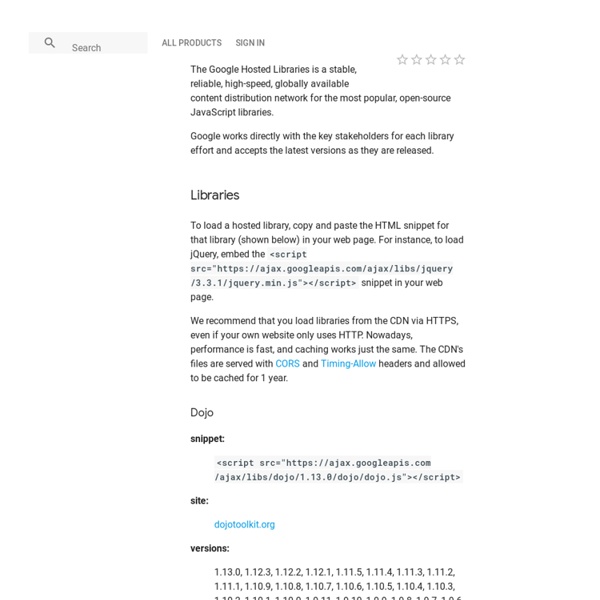



UIZE JavaScript Framework | AJAX, RIA, widgets, JSON, OOP, Class Inheritance, XMLHttpRequest, DOM manipulation, and all that stuff Badass JavaScript jQuery: The Write Less, Do More, JavaScript Library Scriptol.fr, techniques de programmatio Colorbox - a jQuery lightbox A lightweight customizable lightbox plugin for jQuery View Demos Released under the MIT License, source on Github (changelog) Download Install via NPM npm install jquery-colorbox Compatible with: jQuery 1.3.2+ in Firefox, Safari, Chrome, Opera, Internet Explorer 7+ Supports photos, grouping, slideshow, ajax, inline, and iframed content.Lightweight: 10KB of JavaScript (less than 5KBs gzipped).Appearance is controlled through CSS so it can be restyled.Can be extended with callbacks & event-hooks without altering the source files.Completely unobtrusive, options are set in the JS and require no changes to existing HTML.Preloads upcoming images in a photo group.Currently in use on a million-plus websites. Instructions & Help The FAQ has instructions on asking for help, solutions to common problems, and how-to examples. Usage Colorbox accepts settings from an object of key/value pairs, and can be assigned to any HTML element. Settings Public Methods Event Hooks Hey,
Learning JavaScript Design Patterns Design patterns are reusable solutions to commonly occurring problems in software design. They are both exciting and a fascinating topic to explore in any programming language. One reason for this is that they help us build upon the combined experience of many developers that came before us and ensure we structure our code in an optimized way, meeting the needs of problems we're attempting to solve. Design patterns also provide us a common vocabulary to describe solutions. This can be significantly simpler than describing syntax and semantics when we're attempting to convey a way of structuring a solution in code form to others. In this book we will explore applying both classical and modern design patterns to the JavaScript programming language. Target Audience This book is targeted at professional developers wishing to improve their knowledge of design patterns and how they can be applied to the JavaScript programming language. Acknowledgments Credits Reading We already use patterns everyday
Developer Network Free jQuery Plugins and Tutorials - jQuery Script Getting Within the download you'll find the following file structure and contents, logically grouping common assets and providing both compiled and minified variations. Once downloaded, unzip the compressed folder to see the structure of (the compiled) Bootstrap. You'll see something like this: bootstrap/ ├── css/ │ ├── bootstrap.css │ ├── bootstrap.min.css ├── js/ │ ├── bootstrap.js │ ├── bootstrap.min.js └── img/ ├── glyphicons-halflings.png └── glyphicons-halflings-white.png This is the most basic form of Bootstrap: compiled files for quick drop-in usage in nearly any web project. Please note that all JavaScript plugins require jQuery to be included. Bootstrap comes equipped with HTML, CSS, and JS for all sorts of things, but they can be summarized with a handful of categories visible at the top of the Bootstrap documentation. Docs sections Scaffolding Global styles for the body to reset type and background, link styles, grid system, and two simple layouts. Base CSS Components JavaScript plugins <! <!
JavaScript pitfalls: null, false, undefined, NaN - MapbenderWiki From MapbenderWiki Comparison operators Comparison via == Equality, regardless of type. Comparison via === Identity, types must match. Pitfalls using comparison Evaluates to false in boolean operations. var x = 0; var y = false; x == y → true x === y → false "" (empty string) Evaluates to false in boolean operations. var x = ""; var y = false; x == y → true x === y → false null Evaluates to false in boolean operations. var x = null; var y = false; x == y → true x === y → false undefined If a variable hasn't been declared or assigned yet (an argument to a function which never received a value, an object property that hasn't been assigned a value) then that variable will be given a special undefined value. Evaluates to false in boolean operations. var x; var y = false; typeof(x) → undefined (as a string) x == y → true x === y → false NaN Not a Number, generated when arithmetic operations return invalid results. Evaluates to false in boolean operations. var x = 10/seventeen; x → NaN Source
Exceptional Performance Yahoo!'s Exceptional Performance team promotes best practices for improving web page performance. They conduct research, build tools, write articles and blogs, and speak at conferences. Best Practices The Yahoo! YSlow for Firebug Use the YSlow tool to analyze a web pages and get a report on why the web page is slow based on the best practices for high performance web sites. Research Research conducted by the Exceptional Performance team is documented in the following Yahoo! Developer Support & Community Web page performance and the YSlow tools are discussed in the Exceptional Performance Group. You can also use the feedback form to report feedback, bugs, and request features. Videos About High Performance Web Pages Both general web development and performance-related videos are available on the Yahoo! Books About High Performance Web Pages